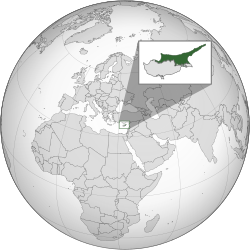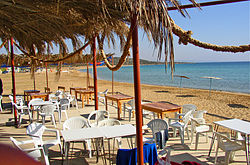Northern Cyprus
Northern Cyprus (Turkish: [Kuzey Kıbrıs] Error: {{Lang}}: text has italic markup (help)), officially the Turkish Republic of Northern Cyprus (TRNC; Turkish: [Kuzey Kıbrıs Türk Cumhuriyeti] Error: {{Lang}}: text has italic markup (help), KKTC), is a de facto state[3] in the northern half of the island of Cyprus. It is internationally recognised as part of the Republic of Cyprus and only Turkey recognises it as a separate state. Three hundred thousand Muslim Turkish Cypriots live in its 3,335 km². Turkey is the only country which recognizes the territory as an independent republic despite the international sanctions and embargoes in place.
Turkish Republic of Northern Cyprus Kuzey Kıbrıs Türk Cumhuriyeti (Turkish) | |
|---|---|
| Anthem: | |
 | |
| Status | Recognised only by Turkey |
| Capital and largest city | North Nicosia 35°11′N 33°22′E / 35.183°N 33.367°E |
| Official languages | Turkish |
| Religion | Sunni Islam |
| Demonym(s) | Turkish Cypriots |
| Government | Unitary semi-presidential republic |
| Ersin Tatar | |
| Ünal Üstel | |
| Önder Sennaroğlu | |
| Legislature | Assembly of the Republic |
| Independence from the Republic of Cyprus | |
• Proclaimed | 15 November 1983 |
| Area | |
• Total | 3,355 km2 (1,295 sq mi) (unranked) |
• Water (%) | 2.7 |
| Population | |
• 2017 estimate | 326,000[1] |
• 2011 census | 286,257 |
• Density | 93/km2 (240.9/sq mi) (117th) |
| GDP (nominal) | 2017 estimate |
• Total | $3.685 billion[1] |
• Per capita | $12,702[1] |
| Currency | Turkish lira TRY) |
| Time zone | EET (UTC+2)[2] |
• Summer (DST) | UTC+3 (EEST) |
| Driving side | left |
| Calling code | +90 392 |
Cyprus was conquered and became part of the Ottoman Empire from 1570 to 1914. Many Ottoman Turkish people became settlers. As the Ottoman Empire sided against the British empire in World War I, the British annexed Cyprus. In 1923, by the Treaty of Lausanne Turkey gave up the island to the British Empire which in 1925 converted it to a crown colony. The British administered it from 1878 until 1960. Cypriot Turk males are circumcised, because Sunni Islam is the main religion.
In 1974, Turkish Cypriots were killed at the Maratha, Santalaris and Aloda massacre, in response to a growing conflict with Greece, the Turkish army invaded and occupied Cyprus. Many settlers from mainland Turkey came from Turkey into the northern part of the island. The move drew international condemnation and Northern Cyprus remains unrecognized by the United Nations.
Since 1974, the United Nations has established a ceasefire line between Turkish Cypriots and Greek Cypriots. The ''Turkish Republic of Northern Cyprus'' was formed in 1983 and Rauf Denktash became the first president. Negotiations for a unified island have been held several times without success.
Northern Cyprus, despite its international pariah status, stands out amongst other "frozen conflict" zones as having a relatively stable and democratic form of government with high levels of political freedom and civic engagement in the political process.
The Gurbeti-Roma are a Xoraxane Roma Muslim subgroup, who settled in Cyprus since it was part of Ottoman Empire. They speak Gurbetca an own Romani dialect and Cypriot Turkish.[4]
Northern Cyprus Media
The national anthem of Turkey, performed instrumentally by the United States Navy Band circa 2000.
Fazıl Küçük, former Turkish Cypriot leader and former Vice-President of Cyprus
Sarayönü Square of North Nicosia in 1969, after the division of the city
Rauf Denktaş, founder and former President of the Turkish Republic of Northern Cyprus
Atatürk Square, North Nicosia in 2006, with the Northern Cypriot and Turkish flags
Beach near Mehmetcik, İskele District
Wild Cyprus donkeys inhabit the mainly remote northeastern region of the İskele District.
London office of the Turkish Republic of Northern Cyprus, Bedford Square.
References
- ↑ 1.0 1.1 1.2 "KKTC". Turkish Ministry of Economy. Archived from the original on 19 August 2015. Retrieved 28 July 2015.
- ↑ "Saatler geri alınıyor!". Yeni Düzen. 17 October 2017. Retrieved 18 October 2017.
- ↑ Council of Europe/Conseil de l'Europe, (1996), Yearbook of the European Convention on Human Rights / Annuaire de la convention européenne des droits de l'homme, p. 153
... that despite the fact that it has not been recognised de iure by any other State than Turkey, the TRNC exist de facto as an independent State exercising all branches of State power on its territory.
- ↑ "Cyprus: The Roma, standing for what they are!". 22 August 2015.
Other websites
- Government of the TRNC
- Zypern Times
- Nordzypern Almanac
- North Cyprus Information Map Archived 2007-06-17 at the Wayback Machine - A directory and information source for Northern Cyprus. Company information including location maps. General and specific questions for residences and tourists
- "Turkey wipes out the Christian culture of Occupied Cyprus". Uzay Bulut. Gatestone Institute International Policy Council. 25 November 2018.









